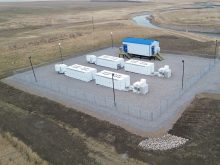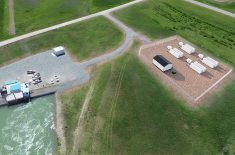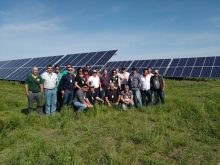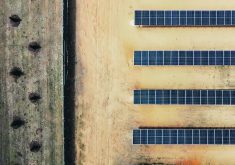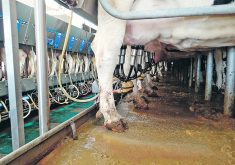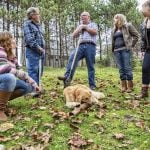A proposed solar project east of High River, Alta., is to be built near a lake listed as one of Canada’s most important areas for birds, raising concerns it could harm species such as waterfowl.
Sunlight inadvertently reflected by about 445,000 photovoltaic modules or panels at the Foothills Solar Project could potentially be mistaken by birds as being reflected off water, said Ian Urquhart, executive director of the Alberta Wilderness Association (AWA).
He feared the approximately 1,500-acre development by Elemental Energy near Frank Lake could cause birds to be killed or injured by colliding with the panels. The lake is one of the sites in Canada listed under the international Important Bird and Biodiversity Areas Program.
Read Also

Manitoba Parkland research station grapples with dry year
Drought conditions in northwestern Manitoba have forced researchers at the Parkland Crop Diversification Foundation to terminate some projects and reseed others.
Related story: Placing solar panels on building seen as preferred option
“It’s been identified as the most important wetland in southwestern Alberta for breeding waterbirds. And (they’re) proposing to essentially put in what might appear to birds to be an extension of that lake immediately adjacent to it.”
However, Elemental Energy is “working with subject matter experts, including a professional biologist, to design the (Foothills Solar) Project in a manner that minimizes impacts on the environment, including waterfowl and migratory birds,” said director of project development Dan Eaton in an email Jan. 20.
“We are engaging with relevant regulatory agencies and consulting with stakeholders in advance of filing our application with the Alberta Utilities Commission.”
A wildlife directive issued in 2017 by Alberta Environment and Parks said there are many unknowns surrounding the direct impact of solar projects on species ranging from plants and mammals to birds.
The “lake effect” is described as a hypothesis that suggests birds are attracted to arrays of solar collectors or reflectors because polarized light is reflected at a similar wavelength as water, potentially making such projects look like a lake.
Although it has been documented in other locations that some waterbirds have been killed while attempting to land on solar panels, the directive said further research must be conducted to determine if the hypothesis is applicable to Alberta.
However, it said solar development in the province should not occur in areas such as native grassland or parkland, or within 1,000 metres of a named lake or waterbody. “Solar energy projects that are appropriately sited and (designed) avoid or minimize these effects.”
The Foothills Solar Project is to be built on zoned agricultural land 1,000 metres from Frank Lake at its closest point, said Heather Hemingway, director of planning for Foothills County. She added the lake is a wetland whose limits expand and contract due to things such as precipitation or drought.
Urquhart said the directive also says solar projects shouldn’t occur within 1,000 metres of a wetland-based Important Bird Area. He estimated a substantial portion of the proposed solar project is within that limit for the area surrounding Frank Lake.
Ducks Unlimited Canada, Alberta Operations “supports the pursuit of green energy projects in Alberta, provided they are delivered in accordance with applicable regulatory requirements,” it said in an email Jan. 20.
“We continue to follow the evolving science around solar power installations, to better understand potential impacts on waterfowl, wetlands, and other important waterfowl habitats. As a portion of the proposed Foothills project appears to fall within the Frank Lake Important Bird and Biodiversity Area, DUC urges the applicant and regulator to ensure all necessary steps are taken to mitigate negative impacts.”
The project is to generate 150 megawatts of renewable electricity through a preliminary design involving about 445,000 photovoltaic modules, said a community newsletter in November by Elemental Energy. These are to be bifacial, or double-sided, increasing their power generation while using less land, it said.
They are to be installed on a single axis tracking system, allowing them to rotate to follow the sun throughout the day. Preliminary plans also include the construction of internal access roads, 54 inverter/transformer stations, an electrical collection system, and a project substation to connect it to Alberta’s electric system.
“Elemental is exploring options to connect the project to the grid,” said the newsletter. “The interconnection is subject to a separate public consultation and regulatory permitting process.”
The company has completed what it called comprehensive environmental studies that included wildlife and vegetation, along with wetlands delineation and habitat mapping. It said an assessment has also concluded the panel tracking technology will prevent potential glare from being reported at things such as nearby residences or roads.
“We’re committed to projects that generate environmental benefits, positive social impacts for the communities in which we work, and long-term economic benefit.”
These include the creation of up to 200 jobs during construction, followed by employing a team of workers to support the facility for up to 35 years, said the newsletter. Besides generating economic spinoffs and what it called significant property tax revenue for Foothills County, the company will also create a community benefit fund “to support local initiatives, education programming, and other special projects.”
However, although the AWA supports renewable energy, Urquhart said “it doesn’t mean we’re prepared to write renewable energy developers a blank cheque and give all of their projects the thumbs up. And we have to look closely at these projects and see whether other conservation values like wildlife mortality (and) loss of critical habitat are going to be severely compromised …”






